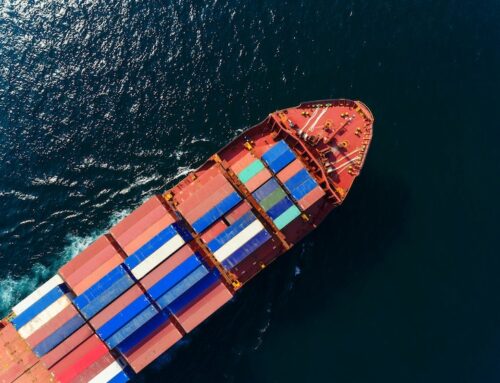In response to an extraordinary rainfall shortage, the Panama Canal has been forced to restrict the number of vessels passing through it. With trade volumes through the canal falling by 49% compared to its peak, we review how the Panama Canal Authority (ACP) is working on finding solutions to address water scarcity and mitigate the drought’s impact on global trade.
The construction of the Panama Canal stands as a landmark feat in 20th-century engineering. Its inauguration in 1914 marked a significant milestone, creating a vital link between the Pacific and Atlantic oceans, revolutionising global shipping routes. In normal times about 5% of global maritime trade uses the Atlantic-Pacific shortcut, and 40% of US container traffic. However, the foresight of its creators did not anticipate the profound impact of climate change to this iconic waterway, which has brought unforeseen challenges, including drastic fluctuations in water supply, a century later.
ACP Response to Crisis
In response to the prevailing drought conditions, the Panama Canal Authority (ACP) has responded by implementing toll rate hikes and imposing restrictions on vessel transits, leading to escalated shipping expenses, particularly for US energy commodities. Panamanian authorities have enforced limitations on passage, reducing the daily allowance from approximately 36 to 24 ships. Additionally, each vessel is now operating with reduced cargo loads due to imposed weight restrictions.
Rainfall Vital to Canal Operations
Rainfall plays a critical role in the functionality of the canal. Ships embarking on the journey, navigate through a narrow passage and ascend over 26 meters above sea level into Lake Gatun, a man-made reservoir, via a series of locks. Upon reaching the other side of the canal, the process is reversed, with vessels descending to sea level through a separate set of locks before exiting onto the opposite continent. Approximately 52 million gallons of freshwater are necessary for each transit to facilitate the lifting and lowering of ships within the canal. In December, the water levels in Lake Gatun dwindled to unprecedented levels for the season.
Prior to the onset of the drought, ships had the flexibility to secure passage through the canal up to three weeks in advance or opt to queue without a booking. However, the landscape has shifted significantly since then, with wait times increasing up to fivefold in certain instances.
Impact of Rainfall Scarcity
Diminished water levels not only limit the size of vessels capable of navigating the canal but also increase the risks for larger, heavier ships. These larger ships, which sit deeper in the water, face a heightened risk of grounding in shallower areas. Furthermore, the substantial size of these ships requires larger quantities of lake water to facilitate elevation within the locks presenting significant challenges.
The operation of the locking mechanism relies on the availability of freshwater sourced from Lake Gatun and an adjacent reservoir. Each ship passage through the canal consumes approximately 200 million litres of water, a substantial portion of which eventually disperses into the ocean.
Climate Change and Canal Viability
The recent severe drought is being attributed by the ACP and numerous analysts to the intense and prolonged El Niño season of 2023. However underlying factors such as warming ocean temperatures and deforestation in the Amazon region have also been cited as contributing factors.
The Amazon rainforest plays a critical role in Earth’s climate system, serving as the planet’s ‘air conditioning system’ by generating rainfall and moderating global climate. Additionally, it acts as a vital carbon sink, sequestering carbon from the atmosphere. Deforestation poses a significant threat to these functions, leading to increased carbon release, diminished rainfall, and severe droughts. The unprecedented 2023 drought, exacerbated by factors like El Niño and climate change, underscores the interconnectedness of deforestation and its far-reaching impacts. These issues cast doubt on the long-term viability of the canal, amidst unprecedented environmental changes.
Ambitious Investment Plans
The ACP is actively pursuing solutions to mitigate the risk of water scarcity, with plans underway to invest $8.5 billion in sustainability initiatives over the next five years to address climate change effects. More than $2 billion will be dedicated to implementing a more robust water management system. The largest portion ($3.5 billion) will be assigned to infrastructure and equipment, including the installation of a photovoltaic plant, and the purchase of electric vehicles and hybrid tugs.
These endeavours aim to safeguard the renowned waterway’s future. Meanwhile, the ACP has initiated supplementary water conservation measures, including the implementation of water reuse strategies across different lock chambers.
Impact on Global Trade
Global trade is experiencing major disruptions affecting the two key global water routes linking East and West. With transits via both the Panama and Suez Canals currently being compromised, there is significant concern about the ongoing disruption to global supply chains.
Prior to the current Red Sea crisis, larger vessels from Asia sought alternative routes via the Suez Canal. With the recent events causing disturbances in two major global waterways, many carriers are opting to redirect shipments via the Cape of Good Hope, extending transit times by many days. The situation means constantly changing ETAs for ports, and potentially unfortunate delays in the supply chain. The APC intends to increase the number of ships permitted through the Panama Canal’s when rains forecasted in May return, however this opportunity, should it materialise, will only offer a short-term remedy.








